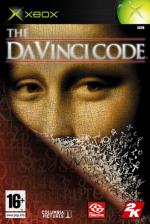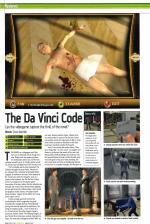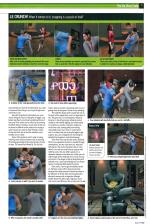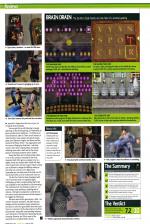
Future Publishing
 1st October 2006
1st October 2006
Categories: Review: Software
Author: Simon Bramble
Publisher: 2K Games
Machine: Xbox (EU Version)
Published in Official Xbox Magazine #57
Can the videogame capture the thrill of the novel?
The Da Vinci Code (2K Games)
Tom Hanks as a videogame star? Nah. Can't see it, especially not at the age he is now. Fleshy jowls are appearing where his cheekbones used to be, and the kids probably wouldn't go for it. Frankly neither would we. Great actor, but digital hero? Pull the other one.
That's probably exactly what developer The Collective thought, because Hanks' likeness as the reluctant hero, university symbologist Robert Langdon, is nowhere to be seen. Some aspects of the movie have crept into the game, such as a couple of the locations, but The Da Vinci Code is more of a companion to the original paper incarnation of the story rather than the celluloid one (actually, the movie's been filmed entirely digitally, but you get the point). Unfortunately, it also means the gorgeous Audrey Tautou, who plays Sophie Neveu (another 'ologist' of old stuff) in the movie doesn't get a look in.
Funnily enough, given all the hoo-hah surrounding the book’s originality, the game instantly feels strangely familiar. The deliberate pacing, the leisurely approach to exploration, the string of complex puzzles... Come to think of it, it's all reminiscent of another languid mystery-adventure, Broken Sword: The Sleeping Dragon. So has The Da Vinci Code been sneakily nicking all its ideas, like some lazy videogame tea-leaf? Well, no, not really. Broken Sword's creator, Charles Cecil, was responsible for many of The Da Vinci Code's new puzzles, hence the huge sense of déja vu. Even some of the conundrums described in the book have been reworked to better fit the game.
And it's the puzzles that really make it. They occur frequently - as in the novel - as Langdon and Neveu try to discover the secrets of the code, and they provide a hefty challenge. But while you may find yourself having to break out the Panadol every now and again to stop your head pounding, the plot's next twists and turns lie tantalisingly beyond a tricky lock or encrypted message. And the game at least provides you with all the information you need to overcome them; thing is, you've got to figure out which bits to use.
Every bit of significant information you come across during the course of the game is logged, and before long there’s an almost bewildering library of facts and trivia, which can be called up by pressing the White button. Finding a crucial piece of info can be almost as difficult as the puzzle you're trying to solve because you need to wade through a series of lists and links, but at least the solutions aren't handed out on a plate.
Some of the set-pieces aren't quite so taxing, involving more obvious solutions such as warding off snarling guard dogs by throwing chunks of meat to them. The mental test offered by The Da Vinci Code is deep and varied, and passing each one and getting closer to the game's climax is very satisfying. The Collective always said it would stay true to the spirit of the original story, and to a large extent it has. The game has a rich atmosphere, helped by being set in lots of big moody cathedrals and art museums with rubbish lighting, but unfortunately it's certainly not a looker. Character models are on the basic side, moving jerkily and looking unnervingly vacant even when in conversation, and it's a shame that just as the plot begins to get a grip on you, you're stopped from becoming too absorbed by the game's visual shortcomings.
Then there's the way the plot itself is delivered. All the story exposition business is handled through conversations, and we must warn you: they don’t half drag on. The central characters talk so much there's a real risk you could end up trying to stuff rolled-up socks into your telly's speakers in a desperate attempt to shut them up. Luckily, you can skip through all the chatty bits if you want, and you will want to. The danger is that by doing that you'll probably miss a vital clue (although you can always retrieve it using that White button function).
Even worse, if you've got the subtitles turned on, half your screen will be obscured at times because of the sheer amount of words that have to be delivered. To be fair, there are few games that attempt to convey such a large plot, although Broken Sword was able to get a big story across with much more efficiency. But at times you'll be tempted to forget about the story so you can simply get back to playing.
You may get fed up with listening to people jabbering on about hitting things, but thankfully the game provides some relief there - it is billed as an action-adventure, after all. There are all manner of robed weirdos, nosey coppers and secret society types stood between Langdon and Neveu and the secrets of the Priory of Sion - the organisation with the means of finding the Holy Grail - and there comes a time when creeping about and quietly collecting clues takes a back seat to the simple pleasure of lamping someone with a dustbin.
Except that there isn't anything simple about it, not at first, anyway. Compared to the more measured bulk of the game, scrapping it out is a slightly clunky and chaotic affair, which will often result in game-over until you've got it licked. Luckily you're allowed to change the difficulty setting as and when you need to, so if a fight proves impassable you can take some of the heat out of it, knock seven bells out of an enemy and move on.
The Da Vinci Code has been developed with a lot of common sense. It's regularly highly challenging, yet there's rarely anything that'll halt your progress for too long thanks to clue-hoovering. The mechanism for clue-hunting is solid, too - on examining a body, painting or anything else of interest, a first-person perspective is entered and the screen can be panned around to fully inspect it for nuggets of information.
But other areas let the game down a little - the wooden character animation, the often tortuous dialogue and the sometimes overly relaxed pace (one area in which the game differs from the book). If you're a newcomer to the phenomenon of all this Jesus-themed, impossible code-breaking malarkey you'll find parts of The Da Vinci Code pretty bloody annoying. However, you'll find more to like, especially if you enjoyed Broken Sword. .
Good Points
- Truly brain-battering puzzles. Even if you've read the book and know the answers, you'll be thrown by some of the all-new inclusions.
- The game drips with the tense atmosphere of the more-popular-than-air book, thanks to some great locations and set-pieces.
Bad Points
- The game is really dialogue heavy, which often detracts from it and even the plot itself. It is a game, after all - not a fancy digital novel!
- The often duff graphics and basic, jerky animation sometimes dispel the feeling of complete immersion in the game.
- Yes, the game is a teaser at heart, but the sedate pace might make you lose interest in playing through to the conclusion.
Verdict
Makes up for its problems by nailing the feel of the story, and the puzzles are some of the most original around.
This article was converted to a web page from the following pages of Official Xbox Magazine #57.
Scores
Xbox Version| Overall | 72% |





